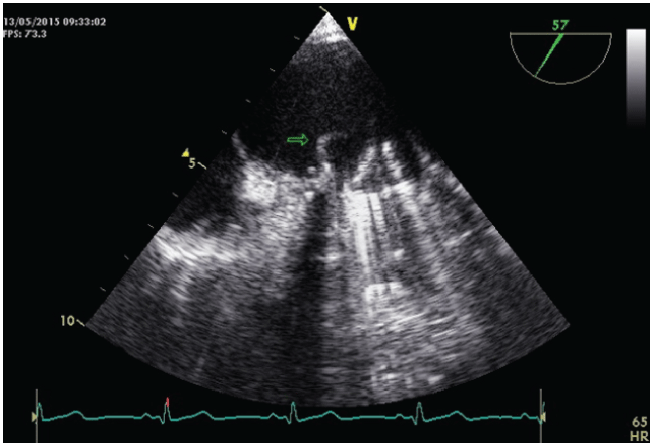A 38-years-old female patient, with the diagnosis of Systemic Lupus Erythematosus and antiphospholipid syndrome (APS). Under hemodialysis for the last 3 years (by a humerus-cefalic arteriovenous fistula) after an 8 years period of peritoneal dialysis which started 4 years after renal transplantation in a patient with Lupus Nephritis.
Important to mention is the mechanical mitral valve due to severe stenosis for rheumatic fever and a long term corticotherapy, in the moment with 10 mg/day of prednisolone.
The patient went to the urgency department complaining of abdominal pain, mainly in epigastric region and left lower quadrant, associated with non-productive cough and rhinorrhea. She stayed hospitalized with the diagnosis of Pneumonia.
Because clinical outcome was not the expected with maintenance of complains, high inflammatory markers and sustained fever, further investigations were done. It was identified multiple splenic infarctions (probably in context of APS) and hemocultures were positive for Candida Parapsilosis. The patient was submitted to an echocardiogram which revealed the presence of vegetation (Figure 1, Figure 2 and Figure 3) in the mechanical mitral valve as well as vegetation in the tricuspid valve (Figure 1).
Initially Amphotericin was started, although not tolerated by the patient with symptomatic side effects. After this, endovenous fluconazol, according to cultures sensitivity, was maintained during 10 days. Because there was no favorable response, with persistent positive hemocultures to Candida P., it was switched to anidulafungin during 30 days. Maintained Candida P. isolated in hemocultures which was controlled only after 10 days of re-initiating Fluconazol, post-hemodialysis. The patient maintained Fluconazol during 11 months.
After one year, there is no evidence of vegetation in tricuspid valve and regression of dimensions in the vegetation of mechanical mitral valve.

Figure 1: The upper two arrows show the 2 vegetation present in the mechanical mitral valve while the lower arrow shows the vegetation in tricuspid valve.

Figure 2: Measurement of one of the two vegetations of mechanical mitral valve.

Figure 3: A big dimension vegetation of mechanical mitral valve.